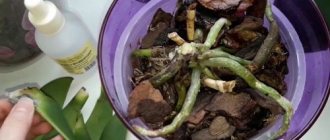Plants » Flowers
0
1479
Article rating
Kira Stoletova
When growing Orchids, flower growers try to make every effort to speed up and increase the duration of flowering. But all the work becomes in vain when the orchid flowers wither for unknown reasons.
Reasons for wilting of orchid flowers
Reasons for wilting of orchid flowers
The fact that an orchid's flowers wither is often the fault of the grower himself, who has poorly organized the care of the plant. When the air temperature, humidity level, watering regime, draft and other reasons are unfavorable, flowers fade.
But it’s not always worth looking for problems in your own mistakes. When buying a blooming flower in a store, it is impossible to predict when it will drop its buds. To avoid such problems, you should buy Orchids with closed flowers or with 1-2 open buds.
Changing the conditions of detention
If the flower arrow of a purchased orchid begins to die, its buds wither and fall off, the reason is often a sharp change in the conditions in which the flower is kept. Orchids are capricious and do not like transportation, especially in cool, windy weather. Simply moving from the store to home leads to stress.
This reason, which leads to the end of the flowering period, is not dangerous for the plant. With proper care, it will get used to the new growing conditions and will delight the grower with large, bright buds.
Unfavorable microclimatic conditions
Temperature and humidity levels are interrelated indicators. Their balance is important for an orchid, especially during the flowering period. The biggest problem occurs in winter. Often the reason that a flower has wilted is dry air. Since orchids are often grown on window sills above heating radiators, the air space around the heating device is subject to change. Dry air negatively affects both the foliage of the plant and its buds.
Frostbite also threatens flowers in winter. In frosts, the flower withers even when in contact with glass.
In summer, in addition to maintaining a comfortable temperature and humidity, it is important to pay attention to protecting Phalaenopsis from the harmful effects of sunlight. The high heating temperature of the space near the window contributes to drying of the peduncle and leaves. The roots of the pet also dry out.
Errors in watering mode
If orchid flowers fade, the cause may be errors in the organization of watering. Withering of buds is a consequence of both a lack of moisture and its excess. When the roots stop receiving the required amount of moisture, the plant can show its dissatisfaction either by the withering of 1-2 buds or all the flowers.
If drought shortens the flowering period of Phalaenopsis, then waterlogging of the soil threatens to rot its roots. When the roots rot, they cannot feed the peduncle and green mass. The most unnecessary parts - the buds - are the first to suffer. The flowers begin to wither and fall off. Subsequent symptoms extend to the leaves of the flower.
Lack of light
The intensity of illumination and the length of daylight hours are the fundamental factors in the growth and development of an indoor flower, as well as the onset of its flowering period. For Orchids, it is normal to be exposed to light 12 hours a day.
Lighting intensity is more difficult. The reason that Phalaenopsis fades is often the flower's dissatisfaction with the lighting spectrum of home lamps. This problem is especially acute in winter, when the length of daylight hours decreases. Without additional illumination with ultraviolet lamps, the pet begins to stop growing, get sick and slowly die.
Pests
If the orchid has become lethargic, the cause of this is often a mealybug attack. This insect sucks juices from the green mass and buds of the plant. In just a few days, the flower can die. Therefore, there will not be much time to save the pet.
Signs of damage by such a pest can be identified by the condition of the leaf blade and trunk. Their surface becomes sticky, and a thin cobweb forms on the surface.
What to do if the orchid fades?
The first thing to do is organize quarantine. Place the plant separately from the rest of your “green friends”. It is possible that the reason is the appearance of pests, so it is better to isolate the flower.
Attention! The main thing is not to perform rescue actions without finding out the reason! Otherwise, you can destroy the orchid. For example, it is known that novice gardeners try to water their pet as often as possible. And this regime is also destructive. Because if in this case, to resuscitate the orchid, you water it even more often, you will lose the flower forever.
It is necessary to carefully examine the condition of the orchid and evaluate:
- root system;
- substrate;
- leaves.
It is very important to find out whether the roots are rotting or drying out? Are there any visible parasites? Remember if you moved the pot? Have there been any noticeable changes in the microclimate recently? By answering these questions, you can draw up the right program of action to save your “green friend.”
Changes in external conditions: temperature, humidity
The cause of poor plant condition can be external conditions:
- dry air;
- low temperature;
- overheating from close proximity to the battery.
Reference! It is worth remembering that in nature, orchids are watered by rain every day. They love humidity! At the same time, the fresh wind of the tropics helps dry out excess moisture before a new downpour.
However, in apartments the microclimate is most often different: dry air comes from the radiators, and the lighting is insufficient. Our task is to bring the atmosphere of a city apartment as close as possible to the conditions of a tropical forest. At least in one single corner!
For this:
- humidify the air (purchase a special device);
- place the pot on stones that can be watered;
- increase the air temperature (for example, buy a heated mat);
- move the pot to a well-lit place;
- buy a phytolamp.
Phalaenopsis transplantation and soil replacement
For an orchid, the substrate is the real foundation of health. Therefore, it is necessary to immediately replant the plant as soon as you bring it from the store. It is possible that the reason for the poor condition of the flower is precisely poor-quality soil. In this case, replanting the plant is recommended. Remember, beauty does not require ordinary soil, but a mixture of crushed tree bark, sphagnum and small stones.
Phalaenopsis needs to be replanted if:
- you still have not replanted the plant since purchase;
- the orchid has not been replanted for more than a year;
- you doubt the quality of the substrate in which the flower is currently growing.
Signs of poor quality soil:
- compacts quickly;
- interferes with the penetration of oxygen to the root system;
- has recognized rot and mold.
Most often, replanting is required if the root system is damaged. The roots may either dry out or rot. The florist should know what healthy roots look like: they are light, hard, dense.
Replanting can save the plant. But for this you need:
- buy a new good pot for orchids;
- use high-quality soil (special substrate);
- remove old soil, as well as rotten or dry roots;
- soak the plant in a disinfectant solution;
- plant in a new container;
- Water only after two weeks.
Timely feeding
Sometimes the cause of flower disease is a lack of fertilizer. It is easy to determine; as a rule, you yourself remember very well the last time you fertilized orchids. If it was really a long time ago, then to save the orchid you just need to feed it!
Our beauty grows in a loose, light mixture that provides almost no nutrition. Therefore, it is recommended to draw up a feeding schedule. The frequency depends on the orchid variety. It is only important to remember that fertilizing should be light and regular.
Another danger is overfertilization. You cannot make a strong solution and feed the plant “for the future” to the maximum. This can cause a chemical burn to the roots!
Peculiarity! Be careful and follow the recommendations on the fertilizer label. Better yet, dissolve the powder even more than the manufacturer recommends. Just in case. After all, an orchid is such a sissy!
Saving a wilting plant
It is important to determine the cause of wilting
If the orchid begins to fade, it is important to determine the main reasons for this phenomenon (since it will not be possible to find the right method otherwise). To save a withered pet, you will have to use one of the following options:
- if the harmful effects of sunlight are suspected, Phalaenopsis should be shaded;
- to prevent the soil from drying out in winter, the heating radiator should be covered with a thick cloth (if the orchid is nearby, on the windowsill);
- eliminate the harmful effects of drafts;
- set a favorable air temperature (22-24°C) in the room where the flower is kept; sometimes the orchid does not bloom because it is frozen;
- increase the level of air humidity in the room using a household device (an alternative method is to install a container of water next to the pot);
- water the plant if necessary.
If the buds wither without blooming, the reason often lies in the poor condition of the plant's roots. The roots may become rotten due to overwatering or suffer from a lack of oxygen. You should prepare the necessary tools, disinfect them and begin resuscitation of your pet:
- You should carefully remove the flower from the pot.
- Rinse the roots with water.
- Trim off affected roots.
- Treat the cut areas with activated carbon or cinnamon.
- Plant the orchid in a new pot with good drainage.
Proper watering
“It’s also science for me to water flowers from a watering can!” - the novice florist will exclaim. But experienced plant growers know that watering is an art. The quality of water, composition and temperature determine the well-being of the orchid. Tap water is not suitable due to the presence of heavy metals.
To water orchids, use soft, purified water.
The accepted practice of settling water for watering plants is not suitable in the case of a strange pet . To purify the liquid, use a filter, a distiller, boil and cool.
If it is not possible to boil or filter, acidification will help reduce the concentration of unnecessary calcium impurities. Apply oxalic acid following the instructions on the drug.
A competent schedule for watering orchids helps to avoid problems with waterlogging and drying out of the earthen clod. Note that the schedule depends on the time of year, temperature and humidity in the room and the life cycle of the plant.
During the active growing season, water the plants 2-3 times a week . During flowering, watering is increased. The principle of watering is simple: make sure that the soil substrate does not dry out or become waterlogged. In winter, watering is reduced, but spraying is not stopped.
How to water:
- using a watering can;
- immersion in the pelvis;
- shower;
- copious spraying.
How much water is needed for irrigation? Water until moisture begins to seep out of the holes in the bottom of the planter . The best time to water is early morning. Remember that proper watering will help avoid difficulties caused by waterlogging and drying out.
We offer a video about proper watering of an orchid:
Pest Control
If the orchid has withered due to pest activity, you will have to organize proper treatment with specialized means. A sluggish orchid will be saved if first aid is provided quickly and efficiently.
Both special preparations and folk remedies can be used against mealybugs. Among the folk methods, the most popular are:
- treating damaged areas with soap solution.
- treatment with infusions of garlic and calendula.
- essential oils.
Traditional methods are effective only for minor damage. A stronger remedy is copper sulfate. Other fungicides are also used (Agravertin, Fitoverm, Aktara, etc.).
What is withering?
The process of wilting means the loss of stiffness, elasticity of leaves or flowers. At the same time, the leaves become like a rag, the turgor disappears, they are soft and dark green in color. The upper parts of the flower, young shoots, and stems bend down. Growth stops, the flower decreases in size. It’s especially disappointing if the buds fade. In this case, emergency measures should be taken to prevent similar occurrences in the future.
When is this process not natural?
There is no eternal flowering in nature. Therefore, withering and then falling off of flowers is a natural process. The inflorescences of one variety please the eye for two to three weeks, while others last for several months. It is easy to determine when the aging period began : the flowers fade gradually and the first ones begin to bloom. They fall mainly from the very bottom of the peduncle. The natural aging process is gradual, and if the flowers all wilt at once, it means something is wrong.
Prevention measures
To avoid wilting of the orchid, you should take care of proper care for it. During the flowering period, you should:
- Maintain a comfortable temperature for Orchids. In summer – 20-25°С, in winter – 16-19°С.
- Organize proper lighting. The light should be diffused. Lighting duration is 12-12 hours.
- Control air humidity levels. It should not fall below 50%.
- Water the plant as the soil dries.
- Apply fertilizer once every 3 weeks, adding mineral compounds to the water for irrigation.
There are also separate requirements for spraying Phalaenopsis during the flowering period. Water entering the buds has a negative effect on them, so this procedure is carried out with caution. Inexperienced Orchid owners should stop spraying temporarily.
Spraying: benefit or harm?
The orchid is sprayed daily, but keep a few nuances in mind. If the air in your apartment is dry, use a humidifier. To prevent the flowers from drying out, bathe the orchid in the shower once a month, and after water treatments, wipe the leaves dry. For spraying to be beneficial, follow the rules :
- The water temperature for spraying is two degrees higher than indoors.
- If the room temperature is below 20 degrees, spray less frequently or eliminate water procedures.
- Spray in the morning.
- Do not spray the flower in direct sunlight under any circumstances, otherwise a burn will occur!
- It is not advisable to spray flowers to avoid stains on them and premature falling off.
If prevention did not help and the flowers began to fall off:
- Reduce the number of sprays.
- Remove faded inflorescences.
- Normalize the light mode.
- Ensure proper watering.
We invite you to watch an informative video about spraying an orchid:
Shock
A change of habitat always causes stress for the plant. This is similar to acclimatization in humans.
New living conditions, a different level of humidity in the room, a different temperature regime - all this is a real shock for the orchid. The plant reacts to such innovations by shedding buds and flowers. This is absolutely normal. Any living creature needs time to adapt, and an orchid is no exception.
Features of proper care and cultivation
In total, there are about 25,000 species and subspecies of orchids and a large number of different hybrids. However, not all of them are suitable for home cultivation. For example, “phalaenopsis” and “cattleya” can grow exclusively in warm rooms, while another type of orchid, “celoginia”, cannot exist without cold. Therefore, when choosing an orchid, you should take this point into account.
One of the common species is “phalaenopsis”. He is very unpretentious, which is why he is loved in our latitudes.
An orchid grows exclusively on other plants. Therefore, in order for an orchid to take root at home, it is necessary to prepare a special substrate for it.
Selection of capacity
When choosing a pot for an orchid, you must follow a number of important rules and principles. Firstly, it must provide ventilation for the root system. Therefore, it is best to purchase a specialized container for orchids, which has small holes. Thanks to them, complete drainage of water from the rhizome is ensured.
Secondly, the pot must provide the flower with sufficient lighting. The best option would be a completely transparent copy.
Thirdly, the material from which the pot is made should not be heated or cooled. The ideal option in this case is plastic. The size of the pot is no less important; it should not be too loose.
Experienced gardeners use ceramic containers in their arsenal. Their main advantage is high air and moisture permeability and protection of the rhizome from overheating. However, a ceramic pot has an extremely unpleasant drawback - the roots of plants stick to the inner wall during long-term use, which can result in injury to the flower during replanting.
A glass pot is a very good option that provides the plant with the necessary amount of light. A significant drawback is the lack of drainage holes. Such products are not suitable for ordinary people, since you need to know the exact amount of water required for irrigation. And this task is only feasible for professionals.
Methods for treating orchids
Once the cause of the plant's wilting is discovered, treatment can begin. The orchid is a fairly resilient plant and is more likely to be revived.
The simplest methods include getting rid of pests using special preparations, watering when the substrate is dry, irrigating the leaves, and wiping with a damp cloth. You can revive the plant by adjusting the watering, irrigation, and fertilizing regimes.
More complex measures include trimming the roots, getting rid of dry or rotten elements, changing the substrate, transplanting into another, more spacious pot, treating the root system with special means.
Transplant technology
If an orchid withers, you need to do an urgent transplant, especially when rotten, dry, injured roots are found. The technology consists of the following steps:
- carefully free the roots from the old substrate;
- carefully examine the roots;
- rinse them carefully under warm running water;
- Use a sharp sterile knife to cut off rotten and dry shoots;
- treat the sections with activated carbon.
Next, you need to leave the orchid without a substrate for several weeks. Then select a suitable pot, a substrate with the correct ratio of the necessary elements and plant the orchid.
Why do orchid leaves wither?
Why does the phalaenopsis orchid wither?
1. Insufficient and irregular watering.
With regular drying (or one, but long-term) and “careful” watering, the plant does not receive enough moisture and uses up the supply of moisture and nutrients found in itself. The lower leaves not only wither, but also wrinkle. They may turn yellow. If you start intensively watering the orchid during this period, it will most likely rot. This will happen due to the fact that some of the roots have dried out and are not working, and since they will constantly be in a wet state, they will begin to decompose and rot will spread to the living roots and neck.
2. A sharp decrease or increase in temperature.
When the temperature drops below a certain threshold, frostbite will occur on the leaves. And with a prolonged increase in temperature above 35-38°C, the root system may stop absorbing moisture and the plant will wither from dehydration.
Orchid root burn.
The above describes the reason why the root system may be damaged and the measures that should be taken to save the orchid. It is better to use specific fertilizers “for orchids”. And buy fertilizer from trusted manufacturers. If you use fertilizers not intended for orchids, be prepared for the fact that the plant may suffer. You should not increase the concentration of the fertilizer, as this will lead to a negative result.
4. Airtight substrate.
Phalaenopsis is an epiphytic orchid, in nature its roots cling to trees and large shrubs, so its roots are in the air and not in the ground. And they need a “breathable” substrate: moisture- and breathable. If the phalaenopsis substrate contains too much sphagnum moss (and this is a very moisture-intensive material), small fractions of bark, and peat is present, then the substrate quickly cakes and loses its ability to “breathe.” Under such conditions, the root system begins to suffer and may even rot.
If the article “Why does an orchid wither?” was useful, you may be interested in the article Phalaenopsis Orchid.
How to dilute a succinic acid tablet for an orchid?
Succinic acid is a unique fertilizer for orchids. Thanks to it, the flower copes with stress more intensively, enjoys longer flowering, grows and recovers faster, and receives the necessary saturation.
The correct dosage is the key to success. If the drug is used in tablets, the application regimen is as follows: one tablet is completely dissolved in 200 ml of water. The next step is to add another 800 ml of water to the resulting concentrate.
Orchid rhizomes should be soaked in the resulting solution for 20-30 minutes. It’s easy enough to spray the leaves; the main thing is to prevent the solution from penetrating into the leaf rosette. To do this, it is best to plug it with a piece of cotton wool or cotton cloth.











